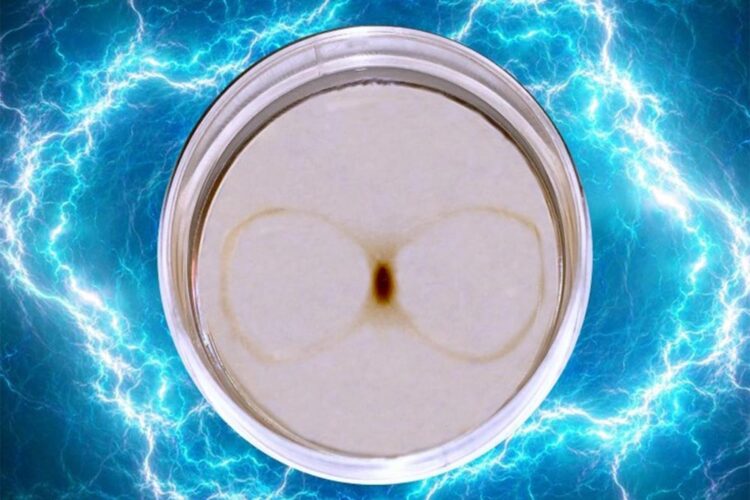UIC researchers describe fundamental processes behind movement of magnetic particles

Pictured is an infinity ring formed by magnetic nanoparticles in response to the magnetic field. The center of the infinity ring represents the ballistic transport where nanoparticles are accumulated, whereas the lighter shade of the ring shows the diffusive transport where nanoparticles are free and diffusing away. This very fundamental process of magnetophoresis is central to various biomedical applications and it also has been protecting the Earth by deflecting the charged particles in the magnetosphere. UIC researchers have developed a predictive model to understand and control magnetophoresis.
Credit: Ayankola Ayansiji and Meenesh Singh
New study published in Proceedings of the National Academy of Sciences.
The motion of magnetic particles as they pass through a magnetic field is called magnetophoresis. Until now, not much was known about the factors influencing these particles and their movement. Now, researchers from the University of Illinois Chicago describe several fundamental processes associated with the motion of magnetic particles through fluids as they are pulled by a magnetic field.
Their findings are reported in the journal Proceedings of the National Academy of Sciences.
Understanding more about the motion of magnetic particles as they pass through a magnetic field has numerous applications, including drug delivery, biosensors, molecular imaging, and catalysis. For example, magnetic nanoparticles loaded with drugs can be delivered to discrete spots in the body after they are injected into the bloodstream or cerebrospinal fluid using magnets. This process currently is used in some forms of chemotherapy for the treatment of cancer.
“We need to know more about how magnetic particles move so we can better predict how fast they move, how many will reach their targets and when and what factors influence their behaviors as they move through various fluids,” said Meenesh Singh, UIC assistant professor of chemical engineering at the College of Engineering and corresponding author on the paper.
Meenesh and colleagues found that four major factors influence the motion of magnetic particles: the difference between the magnetic properties of the particles and the solution they are moving through, the gradient of the magnetic field, the magnetic interactions between particles or how much they stick together, and the interaction of electrical charges on particles with the magnetic field.
“We can build on this new knowledge to increase the specificity by which magnetic nanoparticles reach desired target tissues in the central nervous system,” said Andreas Linninger, UIC professor of bioengineering at the College of Engineering and first author on the paper.
Based on these findings, the researchers created a mathematical formula with all these factors included. Using real-world data, they populated their model and were able to accurately predict the speed and location of particles in real systems.
“By using our model, physicians and researchers will be better able to design magnetic nanoparticles to deliver drugs or other molecules and do so much more accurately,” Meenesh said. “This model can also predict the motion of charged magnetic particles in various applications, including the deflection of charged particles in earth’s magnetosphere.”
###
The research described in this paper, which was co-authored by UIC’s Ayankola Ayansiji and Anish Dighe, was funded by the National Science Foundation (CBET-1706921).
All latest news from the category: Life Sciences and Chemistry
Articles and reports from the Life Sciences and chemistry area deal with applied and basic research into modern biology, chemistry and human medicine.
Valuable information can be found on a range of life sciences fields including bacteriology, biochemistry, bionics, bioinformatics, biophysics, biotechnology, genetics, geobotany, human biology, marine biology, microbiology, molecular biology, cellular biology, zoology, bioinorganic chemistry, microchemistry and environmental chemistry.
Newest articles

Retinoblastoma: Eye-Catching Investigation into Retinal Tumor Cells
A research team from the Medical Faculty of the University of Duisburg-Essen and the University Hospital Essen has developed a new cell culture model that can be used to better…

A Job Well Done: How Hiroshima’s Groundwater Strategy Helped Manage Floods
Groundwater and multilevel cooperation in recovery efforts mitigated water crisis after flooding. Converting Disasters into Opportunities Society is often vulnerable to disasters, but how humans manage during and after can…

Shaping the Future: DNA Nanorobots That Can Modify Synthetic Cells
Scientists at the University of Stuttgart have succeeded in controlling the structure and function of biological membranes with the help of “DNA origami”. The system they developed may facilitate the…



